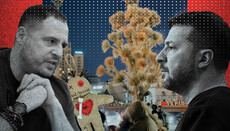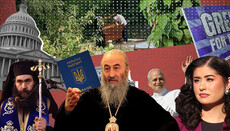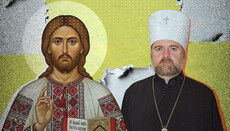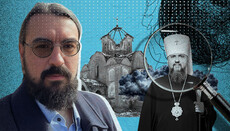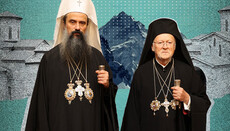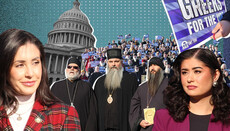How OCU propagandists deceive gullible Ukrainians
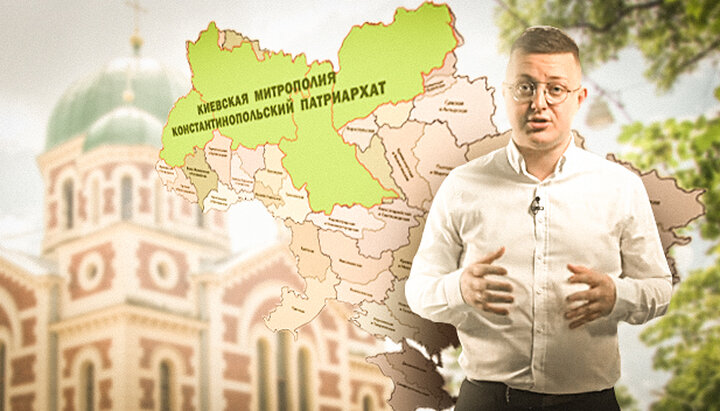
One of the leading OCU adepts became an official of the Lviv Regional State Administration, while inciting hostility among the Orthodox. We analyze his work in details.
Not so long ago, Dmitry Gorevoy, an active propagandist of the OCU, who calls himself a religious expert, was appointed head of the Department for Religious and National Affairs of the Lviv Region. If earlier his numerous manipulative publications on the church topic were only the private opinion of one of the members of the OCU media pool, now each of his statements reflects the position of a state official who has an active influence on the religious situation in the country.
Gorevoy has already managed to make his mark admitting that being in his office, he refused to the UOC communities to re-register their statutes or change the rector several times. According to the official, for this to happen, the communities should change their current name for the ROCU (Russian Orthodox Church in Ukraine – Trans.). At the same time, Gorevoy, whose entire media work has been aimed at promoting the OCU and fighting the UOC for several years, declares that he "does not discriminate against some religious organizations and does not favor others." But the ongoing propaganda activity, in his opinion, is quite compatible with the work of the head of the Department for Religious Affairs, where one of the main qualities should be impartiality and equidistance from any religious conflicts. Gorevoy is sure that state officials may well engage in such propagandist "creative activity", which is quite compatible with his current position.
The public union "Miriane" has already turned to the Lviv RSA with a request to dismiss Gorevoy due to the inadequacy of the position held. It is not known how the Lviv Regional State Administration will react to this call, but we will simply analyze one of the examples of Dmitry Gorevoy's “creativity” and find out how it is “compatible” with his work as a civil servant.
“Woe from propaganda wit” or how to confuse everything possible and impossible
As an example, we decided to analyze one of his many videos on the youtube-channel DetectorUA, entitled "How the Russian Church Annexed the Ukrainian Lands of Constantinople."
Already in the very name, the state official managed to make a number of historical and semantic mistakes. And further even more ... It makes sense to analyze what has been said, firstly, in order to understand the historical truth for oneself and secondly, to once again be convinced of how ridiculous the arguments of the OCU propagandists are, who have now become policy makers in the religious sphere.
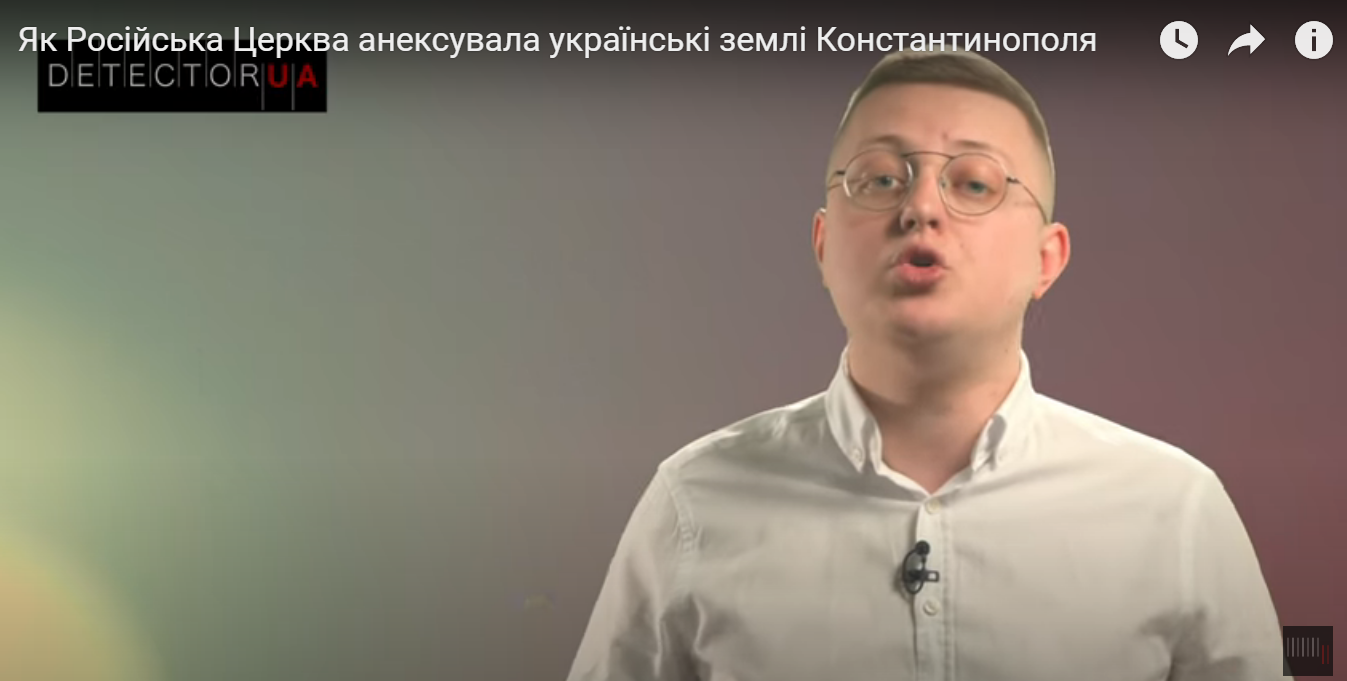
In his video, Dmitry Gorevoy set himself the task of refuting the article "Will Constantinople bring Kiev Metropolia into its fold?" The idea of canceling the transfer of the Kiev Metropolis to the jurisdiction of the Moscow Patriarchate in 1686 had just been voiced in the Patriarchate of Constantinople, and, according to the article, such a cancellation would be the height of absurdity. One of these arguments was that the Kiev Metropolis of 1686 and the Ukrainian Orthodox Church of 2018 are far from being the same despite the fact that the UOC is the successor to that very historical Kiev Metropolis. The current UOC is much more numerous in terms of the number of communities, monasteries, religious educational institutions and much larger in territory. In addition, part of the historical Kiev Metropolis of the 1686 model is now located on the territory of the Baltic states and Belarus. The article provided a map showing the approximate relationship between what Constantinople handed over in 1686 and what it is trying to “recover” now.
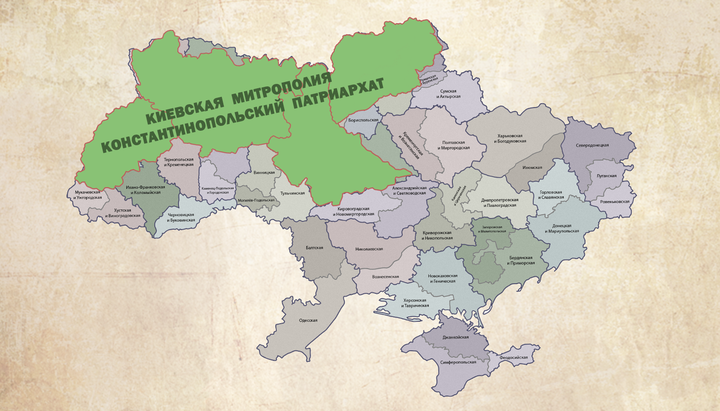
And so the state official undertook to prove that the Patriarchate of Constantinople also owned most of the rest of the "Ukrainian lands", while the "Russian Church" "annexed" it all. It is clear that the OCU adept was tasked with refuting the above article, showing his audience how good the Patriarchate of Constantinople is and how bad the Moscow Patriarchate is, but in order to fulfill this task, he had to confuse everything possible and impossible.
Naming
Firstly, the word “annexation” (from the Latin annexio) is the forcible incorporation by a state of all or part of the territory of another state unilaterally. According to Resolution XXIX of the UN General Assembly of 14 December 1974, annexation is a type of aggression. That is, it is a legal and political science term that is used in international law only in relation to states. In other words, no religious organization can by definition annex anything. And the fact that D. Gorevoy uses this term in relation to the Church once again shows how far the adherents of the OCU are from the Gospel understanding of the Church as the One Body of Christ. Can the Body of Christ "annex" something in itself?
Secondly, the term "Ukrainian lands" really existed and, moreover, it was in the 17th century that it became predominant on European maps and in official documents. But until the 17th century, the lands occupied by modern Ukraine were most often designated as "Rus", "Rusia", "Ruthenia", "Chervonaia Rus", "land of the Cossacks", "Malorosiya", "Hetmanate". But whatever the name, the political power of Byzantium and subsequently the Ottoman Empire did not extend to these lands. One can talk about the political power of Byzantium over the ancient Greek cities in the Crimea, as well as the power of the Crimean Khanate, which was in certain periods of history in vassal dependence on the Ottoman Porte.
But the fact is that Crimea was not included in the concept of "Ukrainian lands" until 1954, when the Presidium of the Supreme Soviet of the USSR transferred the peninsula to the Ukrainian SSR. It can be therefore said that the "Ukrainian lands" never belonged to Constantinople, and, accordingly, they could not be taken away from Constantinople (“annexed” in Gorevoy's terms). In all fairness, it can be mentioned that as a result of the Russian-Turkish, Russian-Polish and Polish-Turkish wars of the 17th century, the Turks and the Crimean Tatars subject to them for some time owned lands in Podillia and in some other parts of Ukraine, but there is nothing to be proud of, since Muslims simply cut out the local population in these lands and drove them to the slave markets of the east. In general, Gorevoy confused the political aspect with the religious one.
Crimea was not included in the concept of "Ukrainian lands" until 1954. It can be therefore said that the "Ukrainian lands" of Crimea never belonged to Constantinople, and, accordingly, they could not be taken away from Constantinople.
Thirdly, the Greek Constantinople ceased to be such immediately after it had been seized by Sultan Mehmed II in 1453. Then this city became Istanbul, although this renaming was documented only in 1930 under Kemal Ataturk. The name "Constantinople" was also used, but if we refer to the fact that someone owned something, then it applies only in relation to Istanbul.
Legend of Crimea
As mentioned above, Crimea was not referred to as "Ukrainian lands" until 1954. Before that, it was inhabited by Greeks, Goths, Scythians, Tatars, Russians, and so on. Conventionally, we can talk about statehood in Greek cities, and then about the power of the Genoese Republic in some parts of Crimea. The statehood of the Crimean Khanate was very conventional, if at all, since the Crimean Khan was a vassal of the Turkish Sultan. Finally, in 1783, Crimea became part of the Russian Empire. However, D. Gorevoy, without any scruples, includes Crimea in the "Ukrainian lands" of Constantinople, annexed by the "Russian Church", and presents the annexation of Crimea to Russia and the exodus of the Christian population from the peninsula as something terrible.
D. Gorevoy: “The first shoots of Christianity sprouted in the Crimea. Christians settled there as early as the first century. Soon the Gothic diocese was formed there. Crimean bishops even participated in the 6th and 7th Ecumenical Councils. In general, the history of Christianity in Crimea is very colorful, extraordinary and dramatic. Church life existed there for quite a long time, albeit with certain interruptions. But the turning point was the annexation of Crimea by the Russian Empire. In 1779 Catherine II issued a Decree or the Highest Charter, as they would put it, whereby she resettled the entire Christian population from the Crimea to the Azov region."
"The annexation of the peninsula by the Russian Empire was a turning point in the church life of Crimea."
Head of the Department of Religious Affairs of the Lviv Regional State Administration
First, D. Gorevoy, in his brief description of the history of Crimean Christians, presented everything as if at first there was flourishing Christianity, but then “evil” Catherine took it and destroyed it, resettling Christians to the Azov region. But one has only to dig a little deeper into history and it becomes clear that the “turning point” in the history of Christianity in Crimea is not its annexation (by the way, in this case, this term is used correctly: the Russian state really annexed the state of the Crimean Tatars), but just the capture of Crimea by these same Tatars in the 15th century. From that moment on, the Crimean Khanate, which was in vassal dependence on the Ottoman Empire, became the center of the slave trade.
Both Crimean Christians and the population of Ukraine proper, then Little Russia (Malorosiya), which was seized by the Tatars during their very frequent raids, were sold into slavery. Crimean Christians were forbidden to put up crosses, repair and build churches, and perform divine services. They were often used for free forced labor and were forced to pay a special jizyu tax. Christians no longer gathered for divine services in magnificent temples, but in private houses, caves and dugouts. The position of Christians in the Crimean Khanate was even more deplorable than in the Ottoman Empire. The dawn of Christianity in the Crimea begins only after the inclusion of the peninsula in Russia. A huge number of temples, monasteries, libraries and theological schools were built shortly after this event. The Crimean Christians finally breathed a sigh of freedom, having got rid of the power of the Tatars, who had caused them so much evil. However, Gorevoy for some reason deems the opposite as true.
Before the annexation of Crimea to Russia, Christians were forbidden to put up crosses, repair and build churches, and perform divine services.
Secondly, the propagandist official, as always, confused everything, and if you call a spade a spade, he told a lie. In his interpretation, Catherine first seizes the Crimea and then removes Christians from there. In fact, everything was the other way around. Crimea was annexed by Russia in 1783, and the exodus of Christians to the Azov region took place in 1778, i.e. 5 (!) years earlier, when Crimea was still under the rule of the Crimean Khanate. Moreover, this exodus took place not at all by the decree of Catherine, but as a result of an international (in today's terminology) agreement between the Crimean Khanate, the Russian Empire, and also the Christian communities of the Crimea: Greek Orthodox, Armenian and Catholic. Additionally, the negotiations on resettlement lasted for 7 years from 1771, the main reasons for such resettlement being, on the one hand, the desire of Russia to poopulate the Azov region, which was deserted at that time, and on the other hand, the threat of massacre of the Christian population by the Tatars, who were extremely unhappy that not long before this, the Crimean Khan, not without the influence of Russia, equalized the rights of Muslims and Christians in some areas. In addition to discontent on the part of the Tatars, Turkey was extremely disappointed with this circumstance, which incited its vassals to an armed interethnic and interreligious conflict, which, if it were not for the resettlement of Christians to the Azov Sea, would have turned into a massacre of Christians, common for the mores of that time.
In Gorevoy’s interpretation, Catherine first seizes the Crimea and then removes Christians from there. In fact, everything was the other way around.
A few more touches to the resettlement picture:
- it took place with the consent of the Christian communities themselves and was not forced, as Gorevoy claims;
- nearly half of the Christians still remained in the Crimea, and none of them was forcibly resettled from there;
- Christians, mainly Greeks, who moved to the Azov region, received reliable protection from any military upheavals. Until 1918, i.e. for 140 years (!), there were no hostilities in this territory at the backdrop of two major wars and many local clashes in Crimea;
- the resettlement of the Greeks was financed from the state treasury of the Russian Empire, including transport costs and settling in a new place;
- migrants were exempted from recruiting for 100 (!) years;
- they received significant tax breaks and direct government assistance;
- migrants received free land plots and vast pastures of the Azov steppes;
- the Greeks had their own elected body of self-government and independence in church affairs;
- after the annexation of Crimea by the Russian Empire, a significant part of the Greeks freely returned from the Azov region to the Crimea.
Finally, the same decree by Catherine II mentioned by Gorevoy and issued a year after the resettlement, in 1779, did not actually resettle the Greeks to the Azov region but assigned specific lands to the already resettled Greeks and granted them the above-mentioned privileges and freedoms.
At the end of the "legend about the Crimea" we say that from the Greek settlers of the Azov Sea came such famous figures as:
- outstanding artist Arkhip Kuindzhi;
- Kiev governor, public figure and scientist Ivan Funduklei;
- the first rector of Kharkiv University Vasily Karazin;
- educator, teacher, scientist and public figure, founder of the first gymnasium in Mariupol Feoktist Khartakhai;
- historian, art critic, corresponding member of the Russian Academy of Sciences Dmitry Ainalov and many others.
And now let's ask ourselves a question: what fate awaited them in the Crimean Khanate under Muslim rule?

Chernihiv "Archdiocese"
D. Gorevoy: “Almost simultaneously with the Kiev Metropolis, Moscow took over the Chernigov Archdiocese, which was part of Constantinople for almost 700 years and only for 330 – of Moscow”.
The Lviv state official had to show the audience how many different things Moscow had “got its hands on”, so he also dragged the Chernigov “archdiocese” into his bogus story. In fact, this diocese was simply part of the historical Kiev Metropolis and, like others, was transferred by the Patriarchate of Constantinople under the omophorion of the Moscow Patriarch.
First, the Chernigov diocese was not any "archdiocese". The term "archdiocese" with the corresponding semantic content is a Catholic term, which is used to refer to important dioceses, both purely Catholic and Uniate. For example, the Kiev diocese of the UGCC is called the "archdiocese". But in Orthodoxy, there are no archdioceses, there are simply dioceses. Gorevoy obviously decided that if the ruling bishop of the Chernigov diocese of the late 17th century Lazar (Baranovich) bore the title of archbishop, which was very rare for that time, then the diocese had to become an "archdiocese." In fact, if a diocese was ruled by a bishop with the title of archbishop, then the diocese was called an "archdiocese." If the next hierarch was a bishop, then it again became a “bishopric”.
Secondly, at that time there really were a lot of difficulties both in church administration and also which of the influential geopolitical players (Russia, Turkey or the Polish-Lithuanian Commonwealth) controlled a certain part of Ukraine. This control passed to one or the other, but the fact is that the Chernigov region came under the control of Russia even before the transfer of the Kiev Metropolis in 1686 and even before the Andrusov Peace in 1667. An interesting situation hence arose: Chernigov region was under the rule of the Russian state, while the Chernigov diocese, together with the entire Kiev Metropolis, was part of the Constantinople Patriarchate. On September 8, 1667, Lazar (Baranovich) was elevated to the rank of archbishop by the Patriarch of Constantinople, which in the language of the then diplomacy meant a very, very friendly curtsey of the Patriarch of Constantinople towards Moscow. Lazar (Baranovich) several times was the locum tenens of the Kiev Metropolitanate, but he never became a metropolitan.
Liquidation of "Brail Metropolitanate" and more
The OCU propagandist is trying with all his might to present the case in such a way that the Russian Church, with fire and sword, destroyed the Orthodoxy of the Patriarchate of Constantinople wherever a soldier of the Russian Imperial Army walked.
As an example, D. Gorevoy cited the situation in Bessarabia: “A similar situation was in southern Bessarabia. As soon as the region came under Russian rule at the beginning of the 19th century, the Moscow Church came here on the bayonets of the Russian army. The Metropolitanate of the Patriarchate of Constantinople, which had existed in the region for several centuries, was unilaterally liquidated."
First, let us ask ourselves a question: what are these “bayonets of the Russian army”, and why did they end up in Bessarabia? It should be noted here that in the 19th century, as in the previous century, Ukrainians (Little Russians at that time) also served in the Russian army not only as soldiers, but also in the rank of officers and generals. In turn, the "bayonets of the Russian army" ended up in Bessarabia for the same reason that they ended up in the Balkans, Bulgaria, Greece (mainly as volunteers), and in other places. They mainly liberated the peoples of these countries from the Ottoman yoke, under which the Orthodox peoples had been groaning for about four centuries. As a result of numerous Russian-Turkish wars, the Russian Empire received relatively small territorial acquisitions, but the peoples of Bulgaria, Serbia, Montenegro, Bessarabia, Greece and so on received freedom and independence.
Let's take the most recent example: on March 25, 2021, Greece celebrated the 200th anniversary of the liberation of this country from the Ottoman yoke with special solemnity. And, by the way, Patriarch Bartholomew of Constantinople, who positions himself as the leader of the Hellenic world, showed particular cowardice before Turkish President R. Erdogan and did not congratulate either the Greek state or the Greeks as a nation on this important date for every Hellenic. The Greek uprising in 1821 was led by a young general of the Russian army, hero of the war of 1812, Alexander Ypsilanti. Although he did not succeed in gaining the support of the emperor in 1821, the victory of the Greek uprising became possible only after Russia defeated Porte in the Russian-Turkish war of 1828-1829. The Ottoman Empire was forced to recognize the independence of Greece by the Andrianople Peace Treaty of 1829.
Several decades later, as a result of the Russian-Turkish war of 1877-1878 and the defeat of the Turkish waxes by "Russian bayonets", together with whom the Bulgarians, Serbs, Romanians and others fought for the liberation of their homeland, Bulgaria, Montenegro, Serbia and Romania gained independence from the Ottoman Empire. In Bulgaria, March 3, 1878, the day of the signing of the San Stefano Peace Treaty between Russia and the Ottoman Empire, is a national holiday – the Day of the Liberation of Bulgaria from the Ottoman yoke.
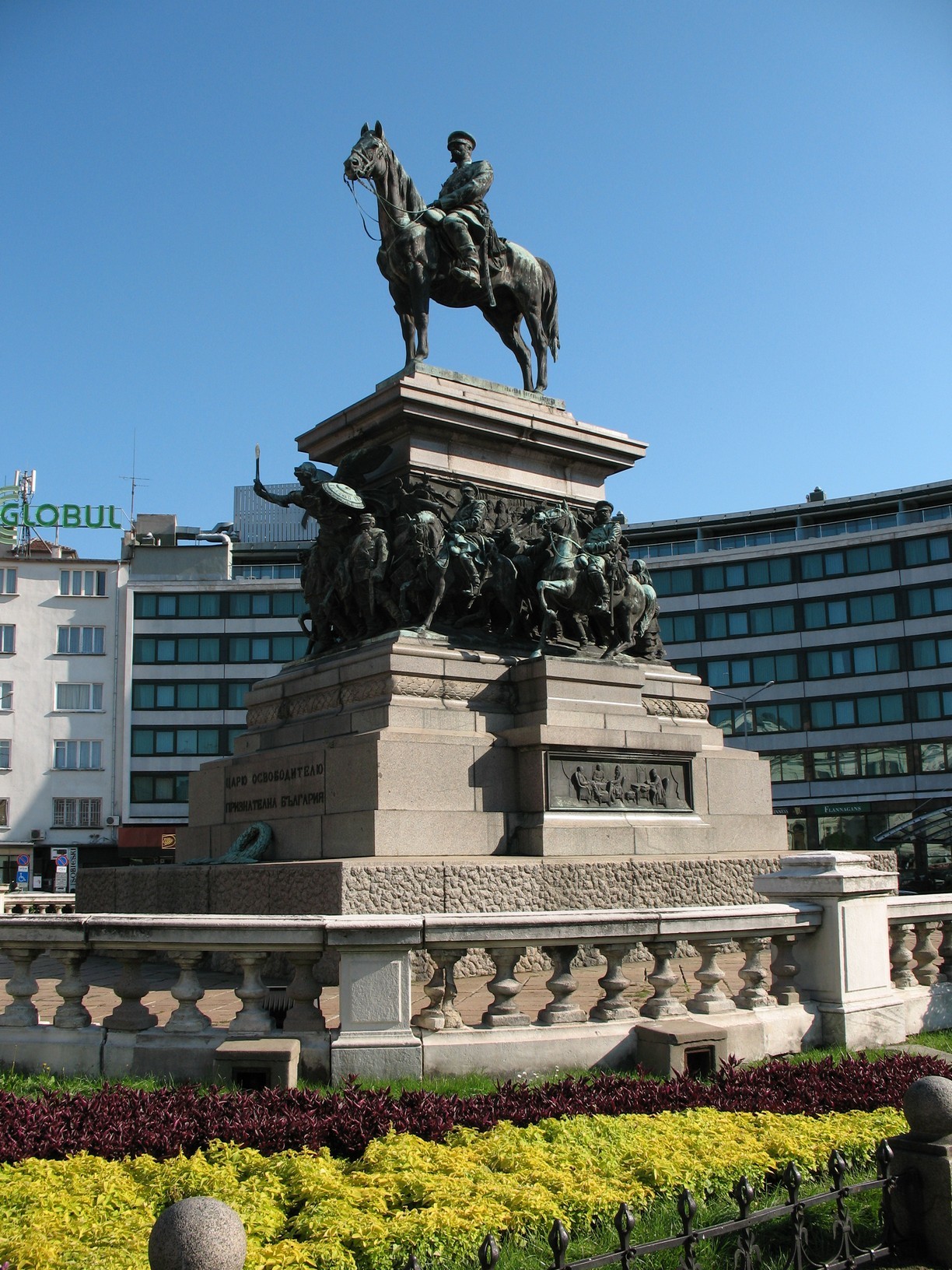
Again, Bulgaria, like other countries in the Russian army, was liberated not only by the Great Russians (Muscovites, whatever you call them), but also by the Ukrainians, who shed their blood for the liberation of their Orthodox brothers. Victories in the Russian-Turkish wars are our victories so among other things, "Bulgaria is grateful" to us as well.
Roughly the same thing happened in the lands of Bessarabia. The Russian army liberated the European peoples oppressed by the Turks and contributed to the emergence of independent states. Russia's own territorial acquisitions were very insignificant. For example, as a result of the Russian-Turkish war of 1877-1878. After gaining independence, Romania received such regions as Wallachia, Moldavia, Northern Bessarabia and Northern Dobrudja. Bulgaria, which then became independent, received Southern Dobrudja. And Russia received just South Bessarabia.
Since the beginning of the 19th century, this Southern Bessarabia passed alternately under the authority of Russia, then again under the Ottoman Empire and, according to the customs of that time, the Brailov or, more correctly, the Proilav metropolitanate passed without any prior arrangement in turns under the jurisdiction of the Moscow Patriarchate and under the jurisdiction of Constantinople.
Secondly, one doesn’t need to imagine a lot what the Patriarchate of Constantinople was like during the Ottoman Empire, and what policy it pursued in relation to the European peoples subject to the Porte.
Below is how the state of the Patriarchate of Constantinople is characterized not by some Moscow propagandist, but by the living bishop of the Patriarchate of Constantinople, Metropolitan Kallistos (Ware), in his book “The Orthodox Church”:
“The top church hierarchy was bogged down in a degrading system of corruption and simony. Entangled in dark affairs and political intrigues, the bishops became victims of ambition and greed. Each new patriarch asked the Sultan for the right to serve in his office and had to pay a high price for this document. The patriarch covered his expenses with the help of the bishops, receiving from each of them a bribe for the appointment of the head of the diocese; those, in turn, robbed the parish priests and the latter robbed their flock. What the papacy was once accused of was an undoubted truth with the Ecumenical Patriarchate under the Turks: everything was for sale."
In relation to the subordinate peoples, Serbs, Bulgarians, Romanians and others, the Patriarchate of Constantinople, in addition to the corruption component described above, pursued a policy of Hellenization, which was manifested in the fact that mainly ethnic Greeks were ordained for episcopal sees and key church posts and no matter how strange it may sound to someone, the Greek language was implanted in worship and church education (where it was the case).
"The Orthodox faith is universal and cannot be reduced to any nation, culture or language, but for the Greeks of the Turkish Empire, ‘Hellenism’ and ‘Orthodoxy’ were inextricably intertwined and much closer than it was in the Byzantine era" (Metropolitan Kallistos (Ware) , "Orthodox Church").
All this led to the fact that the Slavic peoples almost immediately, as soon as they were freed from the Ottoman yoke, raised the issue of church independence from the Patriarchate of Constantinople. Metropolitan Kallistos also writes about it: “But in the 19th century, with the decline of Turkish rule, the borders of the patriarchy were reduced. The nations that won freedom could not remain in church subordination to the patriarch, who lives in the Turkish capital and is closely connected with the political system of Turkey. The patriarch tried his best to maintain the status quo, but in the end he gave in to the inevitable every time. Thus, a number of national Churches emerged from the Patriarchate of Constantinople: Greece (founded in 1833, recognized by the Patriarch of Constantinople in 1850), Romania (organized in 1864, recognized in 1885), Bulgaria (founded in 1871, but recognized only in 1945), Serbia (restored and recognized in 1879).”
And thirdly, what the OCU propagandist calls the “liquidation of the Brailov Metropolitanate” was not its liquidation, but its transformation into the Chisinau and Khotyn Diocese, headed by the ethnic Romanian Gabriel (Banulescu-Bodoni), now ranked among the locally revered saints. In 1813, shortly after the formation of the diocese, the Chisinau Theological Seminary was opened, which was the only (!) educational institution in Bessarabia to educate children of both the clergy and the nobles. In 1816 a gymnasium to train secular officials was opened to the seminary.
In 1814, a printing house was established, which began to publish liturgical books in the Moldavian language. The Moldavian language became widespread in liturgical practice, as well as the Church Slavonic language. In 1814, at the Chisinau Metropolitan House, a house church was built in honor of the Intercession of the Mother of God, where one kliros used the Moldavian language, and the other – Church Slavonic.
With the formation of the Chisinau and Khotyn dioceses, churches and church buildings were actively built and repaired, which the Turks, who ruled here earlier, opposed in every possible way. The diocese underwent significant changes for the better in almost all areas: worship, education, material support.
The successor of Metropolitan Gabriel, Archbishop Demetrius (Sulima), after the start of the Greek uprising (which the Turks tried to suppress) in 1821, sheltered in his diocese more than 10 Greek bishops who were fleeing to Russian-controlled territories, as well as numerous refugees from Wallachia, Bulgaria, Greece and so on. Under Archbishop Demetrius there were opened parish religious schools in Akkerman, Tiraspol, Orhei, Soroca, Ataki, Cahul, as well as church schools in Chisinau, Khotin, Bender and many other cities.
It will take a long time to describe the rapid development of the Chisinau and Khotin dioceses in the 19th century. This development would never have happened if Bessarabia, like other countries, remained under the rule of the Ottoman Empire. So one single question arises: why do OCU propagandists sub-zero all this?
Conclusions
The format of the article does not allow analyzing all the opuses by D. Gorevoy, which he voiced in his video. It would take too long and make the readers bored. The general takeaway is as follows: the propagandist civil servant is not ashamed of any distortions of history and whatever clumsy manipulations in order to hammer into the heads of his audience the thesis about the “spiteful Russian Church”, which was only engaged in “annexing” and destroying everything. This, of course, is not true.
Church history, like history in general, is rather complex and ambiguous. And there have been very difficult moments in the history of the Russian Church. For example, in the same Moldavia, in the ecclesiastic sphere, there is still a confrontation between conventional Russophiles and Romanophiles. There are many paradoxes in history. For example, during the transfer of the Kiev Metropolis in 1686, a fairly significant part of the higher clergy perceived this, to put it mildly, without much enthusiasm, but literally a few decades later, this most Little Russian higher clergy occupied almost all the episcopal sees and significant posts in the entire Russian Church.
It is quite obvious that D. Gorevoy is not just sincerely mistaken in his “creativity”. He deliberately distorts history in order to cause enmity and hatred among the Orthodox of Ukraine. Therefore, this person a priori cannot hold the post of head of the Department of Religious Affairs.
It is quite obvious that D. Gorevoy is not just sincerely mistaken in his “creativity”. He deliberately distorts history in order to cause enmity and hatred among the Orthodox of Ukraine. Therefore, this person a priori cannot hold the post of head of the Department of Religious Affairs.
But even this is not the main trouble about the activities of Gorevoy and other OCU adepts. Their main mistake is that they look at the Church as some kind of socio-political organization that “annexes” something or serves as a pillar of someone’s statehood. However, the Church must be associated, first of all, with Christ, about whom the Apostle Paul said that God the Father "... placed all things under his feet and appointed him to be head over everything for the church, which is his body, the fullness of him who fills everything in every way" (Eph. 1: 22-23). It is not difficult to see Christ not only in the Russian, but also in any other Local Orthodox Church – it is enough to look at the saints who performed their spiritual feat in this Local Church (and sometimes in several Churches). It is enough to ask about their biography and try to assimilate at least a little from them. It is enough to do what Christ, His apostles and all the saints spoke about: "... repent, for the kingdom of heaven has come near" (Matthew 4:17).
